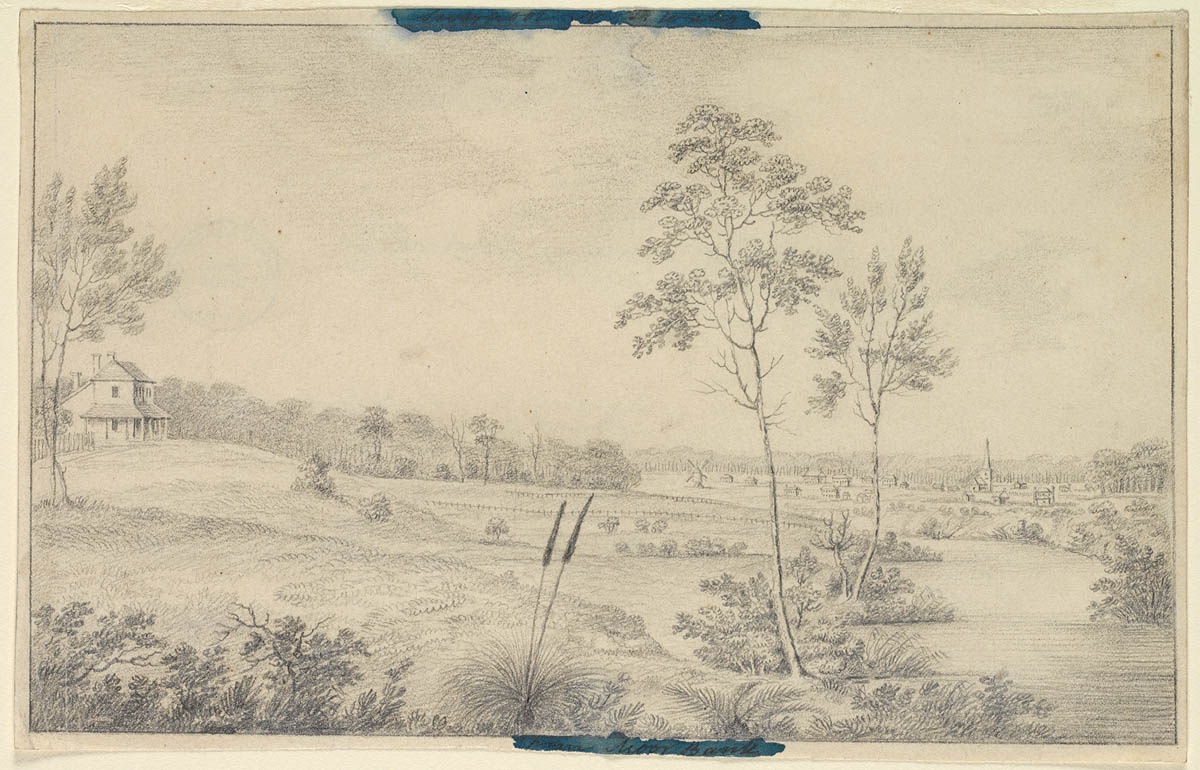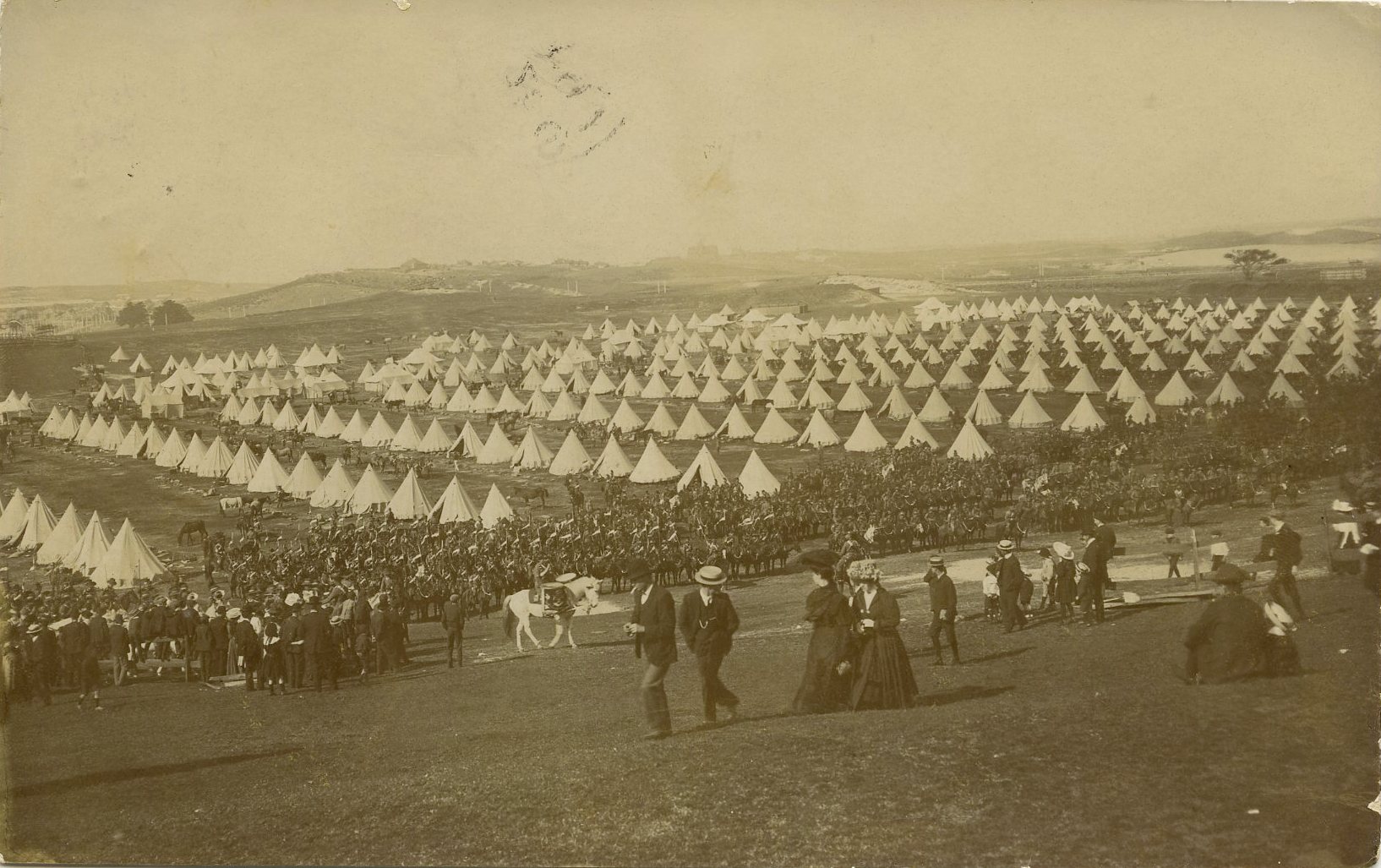Moorebank was gazetted on 7 April 1972. It became part of Liverpool in 1906.
Thomas Moore
The suburb of Moorebank is named after Thomas Moore’s estate Moore Bank. Thomas Moore first arrived in Sydney in 1792 as a carpenter on the Brittania. When in 1796 he decided to remain in Sydney, Governor Hunter appointed him the Master Boat-Builder for the colony. Moore received a grant of 190 hectares at Petersham in 1799 and extended it in 1803. In December 1805 he received another 300-hectare grant on the Tucoreah-Georges River. In October 1809 he resigned as Master Boat-Builder and moved to his property on the Tucoreah-Georges River, which he had named Moore Bank. He was the first European citizen of Liverpool.
Moore Bank Estate extended along the right bank of Tucoreah-Georges River to the junction of Bunbury Curran Creek, the southern boundary of James Meehan’s grant, Macquarie Field, located on the other side of the river. An early view looking up the river from the home at Moore Bank shows cultivated fields and, in the distance, the infant town of Liverpool. The land supported horses and cattle and other farm stock and was originally covered in trees. The method for clearing the land for cultivation was by felling and burning trees.

Moorebank, near Liverpool – The Residence of Thomas Moore Esquire by J.L. Delt, circa 1819. From [Collection of views predominantly of Sydney, Liverpool, and the Sunda Straits, and portraits, ca 1807, 1829-1847, 1887] / owned by A.W.F. Fuller. Image courtesy of the State Library of New South Wales.
Moore was appointed as the Magistrate for the local area in May of 1810. Moore was known as 'the King of Liverpool' for overseeing the development of major public works in Liverpool’s early years as a town. Moore was visited by Governor Lachlan Macquarie and his wife Elizabeth on 7 November 1810. They had breakfast at his substantial two-story brick home and then crossed the river to survey the land that Governor Macquarie approved that day for the site of Liverpool. Moore eventually moved to Liverpool and leased out Moore Bank, which he had increased in size by purchasing the farms around it.
Moore died in 1840, leaving all 2800 hectares of his property to the Church of England. The church established Moore Theological College in his name in 1856 under Bishop Barker. The landholding was sold after 30 years in the 1880s and subdivided into small farms.
Thomas Moore and his wife Rachel are buried in Liverpool Pioneers’ Memorial Park.
Moore Theological College
Moore Theological College was one of the first tertiary institutions in Australia. Thomas Moore left his house and fortune to the Church of England for conversion into a training college for priests. In 1856, his dream was realised with the opening of Moore Theological College. Some of the most important early Protestant clergy in the country were trained there. Training for priests moved into a new Moore Theological College erected near Sydney University in 1889. The buildings at Liverpool were closed in 1890 and demolished around 1926.
Moorebank Library
Moorebank Library was opened on 25 November 1987. In September 1995 it became one of the first public libraries in NSW to offer public Internet.
Notable residents
Lord Kitchener visited New South Wales in 1910 to inspect Australia’s military forces. In Moorebank, Kitchener selected a vineyard homestead, now known as Kitchener Cottage, on Moorebank Avenue as the headquarters for his military training and inspections. Subsequently, a substantial proportion of Moorebank and Holsworthy were acquired by the Commonwealth Government as a military site. Thousands of troops have trained here since World War I.

Moorebank Military Camp, circa 1910
Dominic Syme (1921-2013) first moved to Moorebank in 1940 to start a small poultry farm. He remained an active community member in Liverpool for the rest of his life. At various stages in his life, he was a Liverpool City Council Alderman, Communist Party member, political activist and chicken farmer. He became involved in environmental disputes with Liverpool City Council, The Chicken War, The Vietnam War, and the Jack Lang and Gough Whitlam Campaigns.
In the 1970s he fought against sandmining the Tucoreah-Georges River. The sandy bed of the river had been dredged for sand for the rapid building of houses across the city of Liverpool since the late 1950-60's. By the 1970's, the whole landscape was pockmarked with sand mining lagoons and huge holes. When floods swept through massive areas of banks collapsed.
The mining caused irreversible environmental destruction. Syme played a key role in establishing the Chipping Norton Lake recreation area which turned the lifeless sand mine into a wildlife reserve and recreational area.
Burke, Colleen et. al.. The heart of a place : stories from the Moorebank Women's Oral History Project : covering the suburbs of Moorebank, Chipping Norton, Hammondville and Holsworthy in the Liverpool City Council area (Liverpool: Liverpool City Council), 1992. Catalogue Access: https://liverpool.spydus.com/cgi-bin/spydus.exe/ENQ/WPAC/BIBENQ?SETLVL=&BRN=139704
See something missing?
You know your suburb better than anyone. If you think an important part of your suburb’s history is missing, whether recent or distant, reach out to the Local Studies Team through our online Local and Family History enquiry form. We are always looking for new ways to bring the vibrant history of Liverpool to life!
